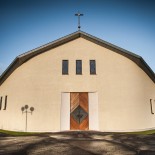Topography and Nomenclature
On the division of the land into shires and boundaries, this parish was located in the County of Coleraine but later called the County of Derry within the Barony of Loughinsolin. As well as Brian Carragh’s fortified dwelling at the Crannoge of Greenlough there was a defensive strongpoint controlling the crossing of the River Bann at Knockanhead (Clements’ Hill) in Glenone. At the western extremity located in Lavey parish is the remarkable fort of Dunglady from which the River Clady and the village of Clady derive their names. This stronghold figures in the ancient annals as an important Royal site. At the northern end in Moyagoney townland is a ringfort which is not indicated in any of the Ordnance Survey maps but is nevertheless a distinctive and prominent feature of the landscape. Another fort was located at Eden, belonging to the O’Neills. There is no trace of this fort now, but the site is marked on the 6-inch O.S map in the townland of Eden on the 200 foot contour line.
The townlands (with suggested meanings in brackets) at present included in the parish of Greenlough are:
- Eden (sloping ground, a brow)
- Ballymacpeake (Townland of the Mac Peake family)
- Moneystagan (Coppice of quickthorn)
- Mullaghnamoyagh (The Hill of Cattle-sheds)
- Glenone (Meadow of two rivers)
- Tyanee (Nee’s House)
- Lislea (Grey Fort)
- Drumlane (Broad ridge)
- Innisrush (Island in the Wood)
- Drumnacanon (Ridge of the cannons)
- Drumoolish (druim-fhualaisce – ridge of thickets)
- Fallaghogey (Fal a’bhogaigh – The Hedged in Bogland)
Other place-names occurring within the townlands are:
- The Hinshinoges (Place abounding in Ash plants – on the left bank of the River Clady opposite the Water Wall)
- Naville in Tyanee (The Orchard)
- Falmore in Tyanee (Great Field surrounded by a hedge)
- Annahagh (Horse-island)
- Annaghclaywood (Island of Columbine – a climbing plant)
- Killycon (wood of the hounds)
- Far Fields (corruption of “Fair Fields”- self explanatory)
- Green Lough (Original name: Innisrush)
- Knockanhead or Clements’ Hill (The Flat-topped Hillock -cnocan-cheideach)
- Currish (low-lying flat ground)
- Killycretan (At Bernard Henry’s lane, Currish, Inverroe – Red River)
- Dunglady (Dun gCloidigh – Fort of The Clady)
- Lurgy (a long, low slope)
- Casan-na-hehir in Tyanee (Causeway over the Moss)
- Cloontimac (cluainte maithe – rich meadows)
- Derrynaveagh (The Oakwood of the Horse)
- Scroggy (The Rough Ground-A place of worship in Penal Times)
- Bogassan (Low-causeway)
- Roohan (Streamlet)
- Edendarragh (Oak-slope)
- Drumbolg (Swollen ridge)
- Ballydoo (Black Farm)
- The Meen (Smooth ground)
- Shanaghy (Old field)
- Cnoc Ban (at Henry McNally’s Eden – The Whitehill)
- Cnoc-Fill-Myroe (Eden – Phelim Roe’s Hill)






